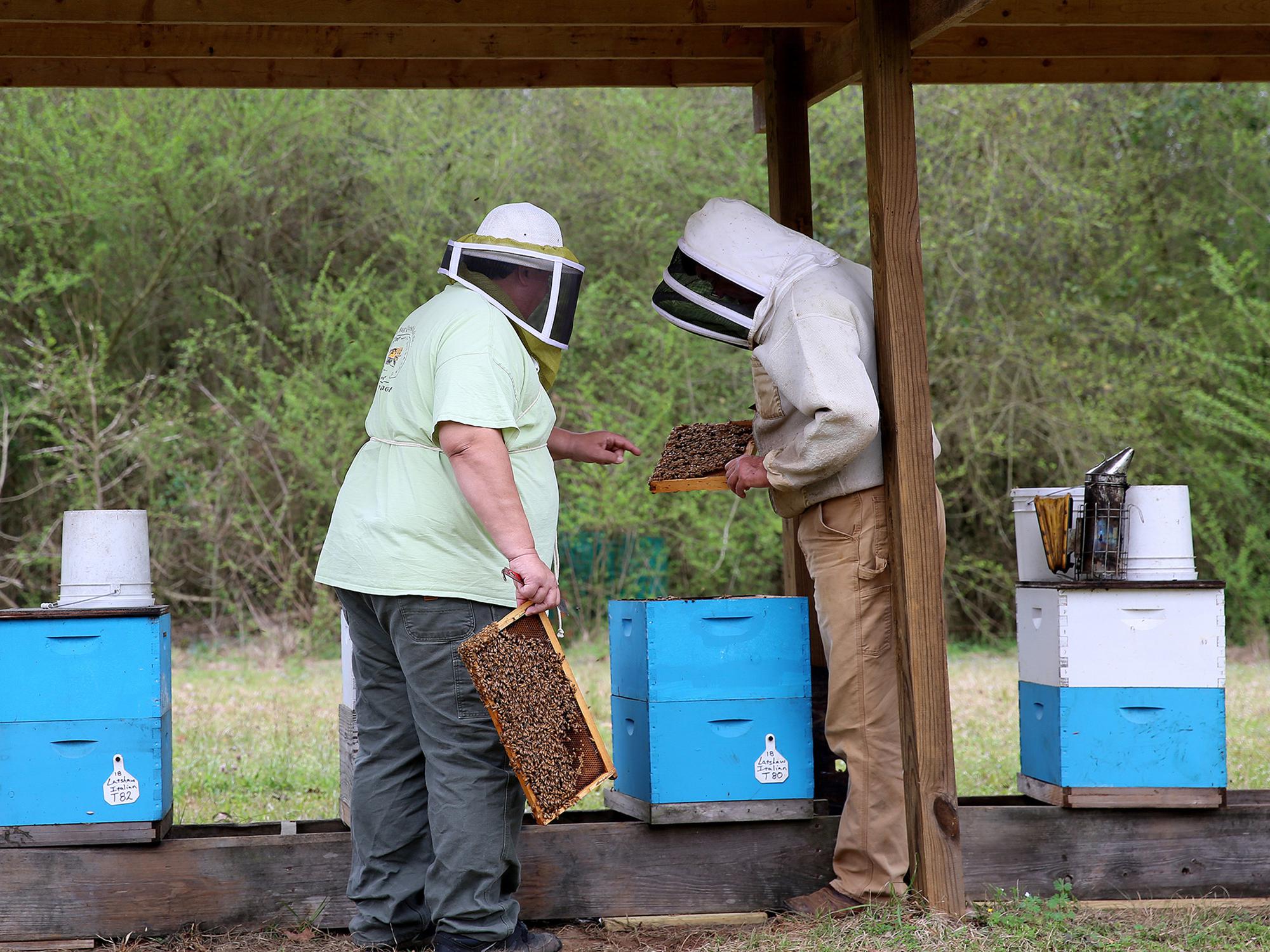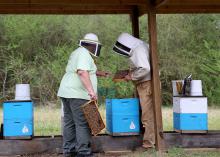Information Possibly Outdated
The information presented on this page was originally released on March 26, 2019. It may not be outdated, but please search our site for more current information. If you plan to quote or reference this information in a publication, please check with the Extension specialist or author before proceeding.
Beekeeping continues to gain hobbyists
STARKVILLE, Miss. -- The number of people in Mississippi taking up beekeeping as a hobby is growing, and commercial-scale production is holding steady -- for now.
“Resident beekeepers in Mississippi are holding their own, despite facing several short- and long-term challenges,” said Jeff Harris, bee specialist with the Mississippi State University Extension Service. “What is sobering is that we’re struggling to recruit young people into the industry. If that keeps up, there will be no one to replace our current producers when they retire.”
While it is considered a small commodity, honey maintains a strong interest among consumers, some of whom become hobbyists. Harris estimates around 900 enthusiasts fall under this category in Mississippi.
Thirty-five to 50 Mississippi families are commercial beekeepers, who manage 3,000-4,000 colonies a year and average 90-110 pounds of honey per harvest.
Beekeeper Johnny Thompson discusses the apiculture industry in Mississippi.
Another factor is the willingness of “sideliners” to join the industry full time. These producers are the 80-100 beekeepers in the state who rely on honey production as supplemental but not sole income.
“It’s amazing the number of people who just want three colonies in their back yard,” he said. “That number has exploded over the last decade, and I don’t think that will drop off any time soon.”
Michael Scheel, president of the Mississippi Beekeepers Association, also believes amateur apiculture is alive and well.
“There’s still a large amount of enthusiasm and interest from the consuming population as a whole concerning honey bees and pollinators,” Scheel said. “From that, we’re seeing more new beekeepers at the hobbyist level.”
Perennial pest and health issues affect a beekeeper’s bottom line. First detected in the U.S. in the late 1980s, the varroa mite is the largest threat to honey bee colonies. Beekeepers have struggled to stay a step ahead of these parasites and keep them from becoming resistant to treatments.
“Colony mortality rates are declining, and we have made progress in mitigating varroa damage, but we still have a long way to go,” Harris said. “Our industry is too small to support the kind of research and development big companies devote to row crops, so in the past we’ve had to use chemicals that have been used for other purposes for varroa mites.”
Harris said a positive development in the commercial industry is the increased use of “soft chemicals” that do not leave behind contaminating residues in wax the way pyrethroids and organophosphates do. These chemicals include organic acids and natural insecticides, such as thymol.
Scheel said hobbyists should be vigilant in controlling varroa mites.
“Some small-scale beekeepers are hesitant to use chemicals to control varroa mite populations,” he said. “Failing to address varroa numbers in a timely fashion can cause significant losses.”
Hobbyists often use nonchemical options for the control of mites that are too expensive for use on a commercial scale.
“These techniques either trap the mites so that they can be removed and killed or prevent bee colonies from growing very large,” Harris said. “Big colonies make more mites; small colonies grow fewer mites. Small colonies also make much less honey. This tradeoff may be agreeable to hobbyists, but commercial beekeepers need to maximize honey production to earn a living.”
Primary sources of honey for beekeepers include many native ground-covering plants, shrubs and trees that bloom heavily in the spring. Additionally, some introduced weed species like privet can be a major source of honey. Many other introduced flowering plants like clovers and agricultural crops can be significant sources of honey and pollen to honey bees.
Another potential threat to commercial beekeeping has been temporarily halted for a review by the Animal and Plant Health Inspection Service. It involves the proposed biological control of the Chinese tallow tree.
More than half of commercial honey in the state originates from this tree because of the amount of nectar its blooms produce. However, Chinese tallow is a nonnative, invasive species that compromises crop, pastureland and many natural ecosystems such as marshes and swamps.
“The USDA wants to introduce a species of flea beetle in these areas that attacks tallow seedlings to keep populations from spreading, but commercial beekeepers rely on tallows heavily,” Harris said. “Many commercial hives produce honey from these plants when they bloom in the spring before they are moved on to soybeans and cotton plants in the summer.”
Harris added that commercial beekeepers fear loss of half of their honey if the trees are eliminated.
“They also fear the possibility of the flea beetle changing its host preference to some of our native trees that are also important sources of honey and pollen for bees,” he said. “A decision on the proposed release of the beetles is expected this year.”
News Story Contact
Your Extension Experts
Related News
Pages
Related Publications
Pages
- « first
- ‹ previous
- 1
- 2
- 3



